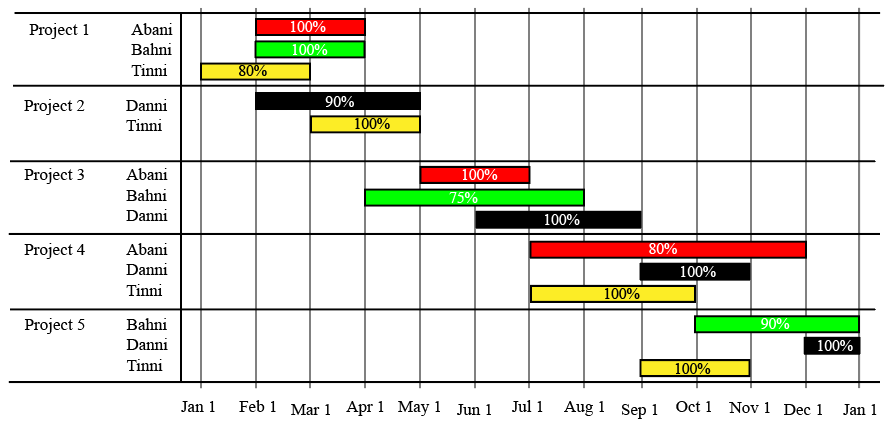Data Interpretation Questions for XAT 2022 – Download PDF
Download Data Interpretation Questions for XAT PDF – XAT Data Interpretation questions pdf by Cracku. Top 10 very Important Data Interpretation Questions for XAT based on asked questions in previous exam papers.
Download Data Interpretation Questions for XAT
Get 5 XAT mocks at just Rs.299
Instructions
The figure above shows the schedule of four employees – Abani, Bahni, Danni, and Tinni – whom Dhoni supervised in 2020. Altogether there were five projects which started and concluded in 2020 in which they were involved. For each of these projects and for each employee, the starting day was at the beginning of a month and the concluding day was the end of a month, and these are indicated by the left and right end points of the corresponding horizontal bars. The number within each bar indicates the percentage of assigned work completed by the employee for that project, as assessed by Dhoni.
For each employee, his/her total project-month (in 2020) is the sum of the number of months (s)he worked across the five projects, while his/her annual completion index is the weightage average of the completion percentage assigned from the different projects, with the weights being the corresponding number of months (s)he worked in these projects. For each project, the total employee-month is the sum of the number of months four employees worked in this project, while its completion index is the weightage average of the completion percentage assigned for the employees who worked in this project, with the weights being the corresponding number of months they worked in this project.
Question 1: The list of employees in decreasing order of annual completion index is:
a) Danni, Tinni, Bahni, Abani
b) Bahni, Abani, Tinni, Danni
c) Danni, Tinni, Abani, Bahni
d) Tinni, Danni, Abani, Bahni
Question 2: The project duration, measured in terms of the number of months, is the time during which at least one employee worked in the project. Which of the following pairs of the projects had the same duration?
a) Project 1, Project 5
b) Project 4, Project 5
c) Project 3, Project 5
d) Project 3, Project 4
Question 3: Which employees did not work in multiple projects for any of the months in 2020?
a) Only Abani, Bahni and Danni
b) Only Abani and Bahni
c) All four of them
d) Only Tinni
Question 4: Which of the following statements is/are true?
I: The total project-month was the same for the four employees.
II: The total employee-month was the same for the five projects.
a) Only II
b) Both I and II
c) Neither I nor II
d) Only I
Instructions
Read the following scenario and answer the three questions that follow.
The following plot describes the height (in cm), weight (in kg), age (in years) and gender (F for female, M for male) of 20 patients visiting a hospital.

A person’s body mass index (BMI) is calculated as weight (in kg) divided by squared height (measured in square metres). For example, a person weighing 100 kg and of height 100 cm (1m) will have a BMI of 100. A person with BMI less than or equal to 18.5 is considered as underweight, above 18.5 but less than or equal to 25 as normal weight, above 25 but less than or equal to 30 as overweight, and above 30 as obese.
Question 5: The BMI of the oldest person considered as normal weight is approximately
a) 20
b) 25
c) 22
d) 24
e) 19
Question 6: The highest BMI among all patients is approximately
a) 20
b) 33
c) 30
d) 27
e) 23
Question 7: The average age of the female patients who weigh 50 kg or above is approximately
a) 62
b) 65
c) 68
d) 70
e) Cannot be determined from the given data
Instructions
Read the following scenario and answer the three questions that follow.
A quick survey at the end of a purchase at buyagain.com asks the following three questions to each shopper:
1. Are you shopping at the website for the first time? (YES or NO)
2. Specify your gender: (MALE or FEMALE)
3. How satisfied are you? (HAPPY, NEUTRAL or UNHAPPY)
240 shoppers answer the survey, among whom 65 are first time shoppers. Furthermore:
i. The ratio of the numbers of male to female shoppers is 1 : 2 while the ratio of the numbers of unhappy, happy and neutral shoppers is 3 : 4 : 5
ii. The ratio of the numbers of happy first-time male shoppers, happy returning male shoppers, unhappy female shoppers, neutral male shoppers, neutral female shoppers and happy female shoppers is 1 : 1 : 4 : 4 : 6 : 6
iii. Among the first-time shoppers, the ratio of the numbers of happy male, neutral male, unhappy female and the remaining female shoppers is 1 : 1 : 1 : 2, while the number of happy first-time female shoppers is equal to the number of unhappy first-time male shoppers
Question 8: Which among the following cannot be determined uniquely?
a) The number of first-time happy male shoppers
b) The number of returning male shoppers
c) All the numbers can be determined uniquely
d) The number of returning unhappy female shoppers
e) The number of first-time neutral male shoppers
Question 9: Which among the following is the lowest?
a) Number of neutral first-time female shoppers
b) Number of unhappy first-time female shoppers
c) Number of unhappy first-time male shoppers
d) Number of neutral first-time male shoppers
e) Number of happy returning male shoppers
Question 10: What is the number of happy male shoppers?
a) 10
b) 15
c) 5
d) 20
e) 40
Answers & Solutions:
1) Answer (C)
The annual completion index for different people is :
The weightage average of the completion percentage assigned from the different projects, with the weights being the corresponding number of months (s)he worked in these projects.
For Abani :
$\frac{\left(\left(100\cdot2\right)+\left(100\cdot2\right)+\left(80\cdot5\right)\right)}{2+2+5}=\ \frac{800}{9}$
For Bahni :
$\frac{\left(\left(100\cdot2\right)+\left(75\cdot4\right)+\left(90\cdot3\right)\right)}{2+3+4}=\ \frac{770}{9}$
For Danni :
$\frac{\left(\left(90\cdot3\right)+\left(100\cdot3\right)+\left(100\cdot2\right)+\left(100\cdot1\right)\right)}{2+3+2+1}=\ \frac{870}{9}$
For Tinni :
$\frac{\left(\left(80\cdot2\right)+\left(100\cdot2\right)+\left(100\cdot3\right)+\left(100\cdot2\right)\right)}{2+2+3+2}=\ \frac{860}{9}$
The descending order for the four people is :
Danni, Tinni, Abani, Bahni.
2) Answer (D)
Considering the information provided :
For project 1 : 3 months.
Project – 2: 5 months.
Project – 3: 5 months.
Project – 4: 5 months.
Project – 5: 4 months.
Among the given options option D is true which is project 3, project 4.
3) Answer (A)
Abani, Banni, and Danni did not work on multiple projects simultaneously in a month
Tinni was the only person who worked on multiple projects which are project 4 and project 5 in the month of september.
4) Answer (D)
The total project month is the number of months Abani, Bahni, Danni, and Tinni individually worked for all the projects combined :
Abani – 2+2+5 = 9 months
Bahni – 2+4+3 = 9 months
Danni – 3+3+2+1 = 9 months
Tinni – 2+2+3+2 = 9 months.
The total employee month for all the five projects is the sum of the total employee-month is the sum of the number of months four employees worked in this project.
Project -1 = 2+2+2 = 6 months
Project -2 = 3+2 = 5 months
Project – 3 = 2+4+3 = 9 months.
Project – 4 = 5+2+3 = 10 months.
Project – 5 = 3+1+2 = 6 months.
Only statement 1 is true.
5) Answer (A)
The BMI of 1st oldest person= $\frac{40}{\left(1.5\right)^2}=\ 17.77$
The BMI of next oldest person = $\frac{61}{\left(1.75\right)^2}=19.9$
6) Answer (D)
For the highest BMI, weight should be as high as possible and height as little as possible.
Hence it is possible with the person with a weight of 69 kg and a height of 1.6m
His BMI will be $\frac{69}{\left(1.6\right)^2}=27$
7) Answer (A)
There are 5 ladies whose weights are 50 or above
There ages are 50,50, 70,60 and 80
Average = 310/5 = 62
8) Answer (C)
From the given data the following table can be created:

Hence the value of x=10

All the values can be uniquely determined
9) Answer (A)
From the given data the following table can be created:

Hence the value of x=10

From the given options, number of neutral first time female shoppers are the least
10) Answer (D)
From the given data the following table can be created:

Hence the value of x=10

Download XAT previous papers [PDF]
We hope these Data Interpretation questions for XAT pdf for the XAT exam will be highly useful for your preparation.





